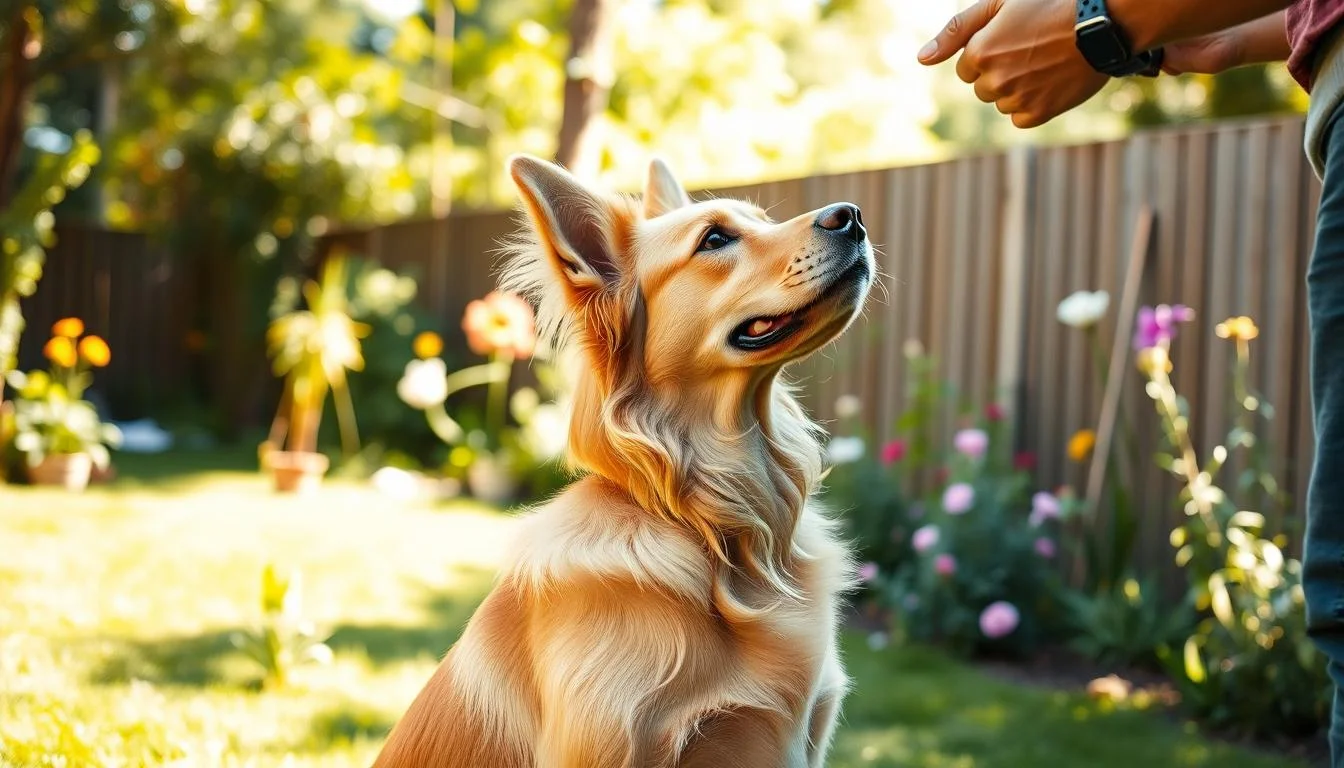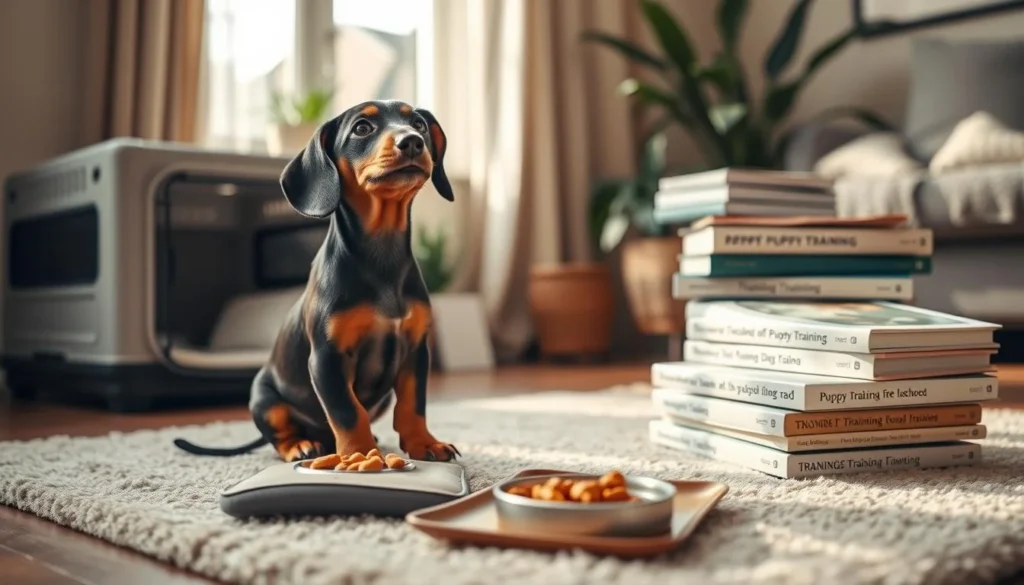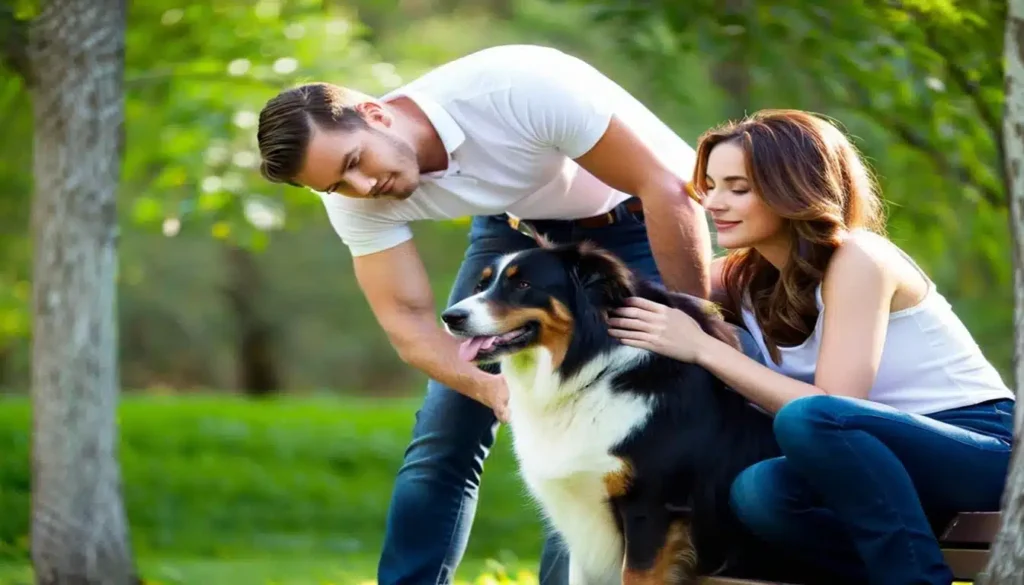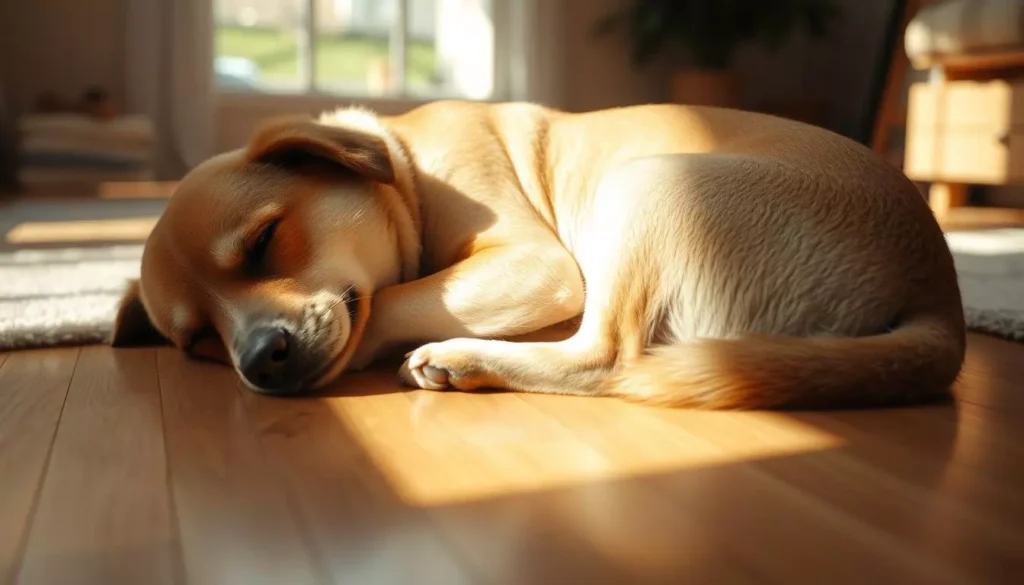I remember the first time my Golden Retriever came in with mud on his paws. His grin made me forgive the mess. His eagerness filled our home with joy but also needed direction.
I learned routines and methods to manage his energy and curiosity. These steps turned chaos into calm.
In this guide, I share what worked for me. It includes temperament, equipment, and a puppy program for home use. It's a practical guide for a week-by-week and lifelong plan with your dog.
Golden Retrievers are smart, social, and eager to please. But they can get bored, over-excited, and mouthy. My training focuses on socialization, routines, exercise, mental stimulation, early handling, and self-control.
Remember, adults need about two hours of exercise daily. They grow physically by 9–12 months but mentally until three years. Seniors show age changes from eight years on. This guide uses the Push Drop Stick method to manage difficulty and motivation.
Key Takeaways
- Golden Retrievers are highly trainable but need mental stimulation to avoid problem behaviors.
- Consistent socialization, exercise, and handling routines are core to success.
- Plan for about two hours of daily activity and a long maturation period up to three years.
- The Push Drop Stick method helps progress difficulty while keeping motivation high.
- This golden retriever training guide focuses on practical, at-home steps and a week-by-week puppy roadmap.
Understanding Golden Retriever Temperament and Training Needs
I work with owners to understand how a dog's personality and upbringing affect its behavior. Golden Retrievers are friendly and eager to please. This makes them quick learners but also prone to boredom. This affects their temperament and training needs.
I break this topic into three parts for easier understanding. First, I discuss breed traits that influence learning. Then, I address common misconceptions about puppy behavior. Finally, I explain how developmental stages impact what to teach and when.
Breed traits that affect training
Goldens were bred to carry items and work with people. Their love for food, water, and play makes rewards-based training effective. Mixing praise with treats and toys keeps them interested. This approach fits well with a golden retriever training plan that matches their natural drives.
Common misconceptions and realistic expectations
Many think a golden retriever training puppy will "train itself" because of their friendly nature. I tell owners to expect individual differences and the impact of upbringing. Puppies from reputable breeders often have better social skills. Still, owners must set routines, rules, and consistent boundaries to avoid problems like excessive mouthing.
Developmental stages and how they impact training
The Angel Phase, from about 2–6 months, is a crucial socialization window. Attention spans are short and teething is common. I focus on short, fun sessions for a golden retriever training puppy and introduce grooming, car rides, and basic cues.
During Teenage Rebellion, roughly 6–18 months, hormones and curiosity increase. I keep training predictable and ramp up physical outlets like retrieving, scent work, or rally. A steady golden retriever training plan helps channel energy into useful tasks rather than unwanted tests of boundaries.
After 18–24 months, signs of maturity appear. I adjust exercise, finalize diet choices, and maintain skills so the adult dog stays reliable. Long-term engagement with jobs and enrichment preserves good manners and strengthens the bond between owner and dog.
| Stage | Key Traits | Training Focus |
|---|---|---|
| Angel Phase (2–6 months) | Short attention span, teething, socialization window | Short reward-based sessions, grooming habituation, basic obedience |
| Teenage Rebellion (6–18 months) | Hormones, increased energy, testing boundaries | Consistent rules, introduce sports and jobs, structured exercise |
| Signs of Maturity (18–24+ months) | Physical and emotional stabilization | Maintain training, finalize care decisions, long-term enrichment |
Essential Equipment for Golden Retriever Training at Home
I have a list of must-have gear for smooth training sessions. The right equipment protects your hands and helps your dog learn calmly. It also makes rewarding your dog's good behavior easier.
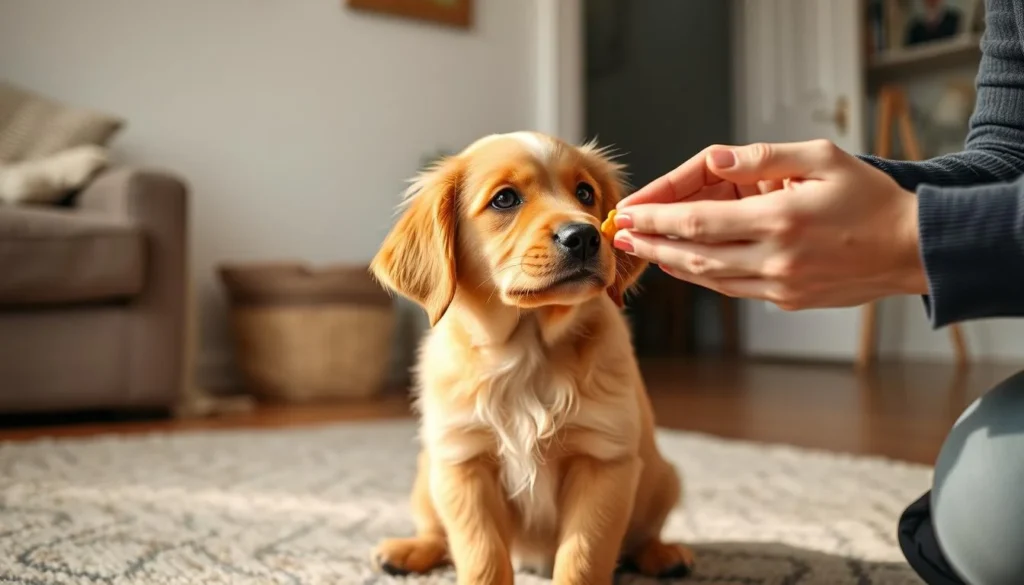
A small treat pouch keeps your hands clean and treats ready. Choose a soft collar that won't rub your dog's coat. A non-restrictive harness is key for control without discomfort. A 2-meter leash is perfect for recall and loose-leash training.
Get a crate that fits your dog's adult size. A playpen is great for short breaks. A non-slip mat or Vetbed is ideal for settling and place training.
Basic gear I recommend
I look for gear that's safe and comfy. Choose harnesses with lots of padding and wide straps. Use stainless clippers or a Dremel for nail care to avoid splits. Durable toys and a sturdy treat pouch save time.
Treats and toys
For early learning, use smelly, high-value treats. Have two toys for fetch and swap them to improve retrieve skills. Rotate toys to keep your dog interested.
Don't overuse treats so praise stays meaningful. Goldens love verbal approval. A good training book helps fade treats as skills improve.
Grooming and husbandry tools
A soft brush and comb remove tangles and feathering. Use toothbrushes and dental chews for fresh breath. Ear and eye cleaning supplies prevent infections.
Bathing supplies help puppies get used to wash handling. Regular grooming makes vet visits easier and training sessions more productive.
| Item | Purpose | Tip |
|---|---|---|
| Treat pouch | Fast access to rewards during drills | Use one with a magnetic or zip closure to keep treats fresh |
| Soft collar | Everyday ID and gentle guidance | Choose a width that won’t rub the coat |
| Non-restrictive harness | Control during leash training without choking | Pick designs tested for escape prevention |
| 2-meter training leash | Balance of control and freedom for recalls | Use braided or flat nylon for durability |
| Crate and playpen | Safe confinement and crate training | Size the crate for adult length and height |
| Non-slip soft mat (Vetbed) | Settling and place exercises | Machine washable for easy cleaning |
| High-value treats | Strong reinforcement during learning | Reserve for hard or new tasks |
| Two identical toys | Swap games and reliable retrieve practice | Durable rubber or rope for retrievers |
| Grooming brush & comb | Coat maintenance and handling tolerance | Brush weekly; comb for tangles |
| Nail clippers or Dremel | Safe nail care and desensitization | File after clipping to smooth edges |
| Toothbrush & dental chews | Oral hygiene between cleanings | Use enzymatic toothpaste made for dogs |
I always have a golden retriever training book ready. It helps me plan, choose treats, and pick the right gear. Good tools make learning fun for both of us.
Creating a Golden Retriever Training Plan and Program
I create a step-by-step plan for owners to train their Golden Retrievers. It fits into their daily routine. Short sessions throughout the day are best for their attention span.
I suggest 3–10 minute sessions for puppies and longer, varied ones for adults. Healthy adult dogs need two hours of exercise daily. This includes walks, play, and training. Puppies and seniors need less to protect their joints.
Setting measurable goals is key. These include a reliable name response, sit, recall, and loose-leash walking. I also focus on crate and potty training. These goals are the foundation of any training guide.
Daily short sessions and high-value rewards keep training fun. Play breaks are also important when puppies get mouthy. This keeps progress steady and enjoyable.
The Push Drop Stick method helps adjust training difficulty. Start with five repetitions at a level. If all are correct, move up a level. If three to four are correct, stay at the same level. If one to two are correct, go back to an easier step.
This method prevents boredom and frustration. It ensures consistent progress in training.
Here's a week-by-week puppy roadmap for a long-term plan.
- Week 1: Settling, name, sit, recall, retrieve, crate, potty, basic handling and varied surfaces.
- Week 2: Leash introduction, noise habituation, car travel, grooming routines.
- Week 3: Harness fitting, “four paws on the floor” for jumping, generalization of cues.
- Week 4: Mat settling, enroll in a puppy class, practice recall and leash work in distracting places.
- Week 5: Increase leash walking distance and tailor socialization to your family lifestyle, such as boating or exposure to horses.
As months go by, I add socialization, handling, grooming, and activity-based “jobs.” This approach turns early wins into lasting habits. The training plan focuses on development during adolescence.
Training frequency is short and frequent, with high-value treats and clear cues. I include play breaks and alternate skill practice to avoid repetition. For long-term maintenance, I schedule monthly refreshers on core cues and increase physical activity to manage weight during teenage growth spurts. This long view completes a usable golden retriever training guide that owners can follow for years.
Household and Puppy Basics: Potty, Crate, and Sleep Training
I want to help you set up clear, calm routines for your new puppy. These early weeks are crucial for your golden retriever training puppy to learn family life. Short sessions, consistent cues, and patient rewards are key when training at home.
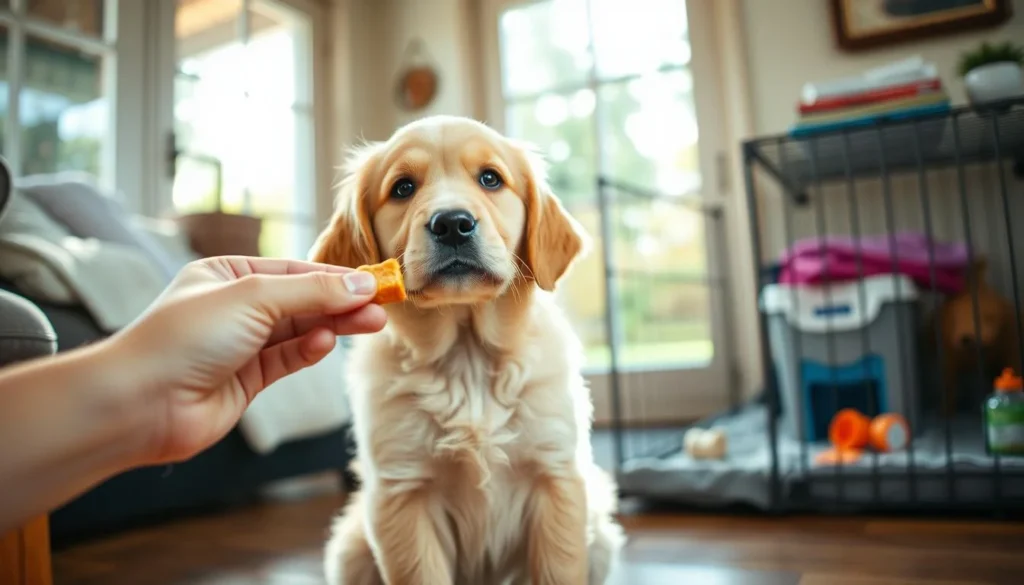
Potty training strategies
Accidents will happen, and never punish your puppy for them. I suggest a schedule tied to naps, play, and meals. Take your pup to the same spot and use a simple cue word.
Praise and a tiny treat after success builds the habit fast. If your pup starts sniffing or circling, interrupt play to go outside. Rewarding each correct toilet reinforces the behavior without confusing the puppy.
If an accident happens indoors, clean the area with an enzymatic cleaner and reset the routine.
Crate training and safe confinement
I treat the crate as a cozy den, never punishment. Start with short, pleasant stays using toys and soft bedding. Give meals in the crate and open the door so the pup learns choice and safety.
Crate size must allow standing, turning, and lying down comfortably. Gradual increases in alone time prevent stress. Crating supports potty schedules, safer travel, and reduced separation problems when built into your golden retriever training program.
Sleep routines for the first weeks
Night wakings are normal. I keep a calm, predictable bedtime routine and allow the crate in the owner’s room to speed settling. Comfort without rewarding persistent crying helps the puppy learn limits.
Avoid long, sudden absences at night. I extend alone time in small steps so the pup gains confidence. Consistent sleep cues help both you and your dog sleep better.
Alone time and husbandry basics
I begin alone training with very short departures and build up slowly. Puzzle toys and safe chews teach independence and reduce anxiety when used with brief, planned absences.
Grooming, brushing, and teeth checks belong in daily routines. I handle paws, ears, and mouth calmly during play so vet visits and care are stress-free. Schedule vaccinations and plan social outings in line with your vet’s advice to keep learning safe.
| Task | Starter Steps | Goal Timeline |
|---|---|---|
| Potty training | Regular outdoor trips, single cue word, immediate reward | Reliable daytime toileting in 4–8 weeks |
| Crate training | Short sessions, meals in crate, comforting bedding | Comfortable 2–4 hour alone periods within 3–6 weeks |
| Night routine | Consistent bedtime, crate in room, scheduled breaks | Longer sleep stretches by 6–10 weeks |
| Alone training | Start with 1–2 minute departures, use enrichment toys | Build to several hours over months |
| Husbandry handling | Short sessions of brushing and mouth checks daily | Calm cooperation for grooming and vet care within weeks |
Training Core Skills: Name, Sit, Down, Recall, and Leave It
I focus on a few key skills to keep life safe and fun with a golden retriever. Short, joyful sessions lay a strong foundation. Using consistent timing, high-value rewards, and gradual distractions helps turn beginner behaviors into reliable responses.
Teaching a reliable name response
I start name training on day one with tiny, upbeat sessions. I say the puppy’s name once and reward them immediately with a treat or a quick game. This practice is done across rooms, on walks, and near other dogs to make the cue general.
Using special golden retriever training treats helps the puppy choose me over distractions.
Building sit and down with cues
I teach sit and down using lures and shaping. I hold a high-value treat and guide the motion until the behavior is smooth. Once the puppy does it reliably, I add a short cue word and phase out the lure.
I use the Push Drop Stick progression to lengthen hold times and add distractions. I also practice sit-to-greet to reduce jumping when guests arrive.
Recall training that works
I treat recall as a safety skill and keep sessions very rewarding. I start in quiet spaces with high-value food and a distinct recall cue like “Come!” I work from a 2-meter training leash or a longer long line before trying off-leash.
I mix recalls into play and mealtimes to keep the command exciting and useful in daily life.
Leave it, drop it, and giving up items
I teach leave it and drop using systematic trading. If my retriever picks up an item, I offer a higher-value trade and praise the exchange. This prevents grabs of dangerous things like mail or frisbees and builds trust.
Progressive exchanges reduce resource guarding while keeping training humane and effective.
Training notes
I train self-control like a muscle by raising challenge levels step by step. I set clear, non-negotiable cues and practice them in distracting places. I use golden retriever training treats and short sessions to keep motivation high.
This steady approach turns early lessons into everyday habits.
Leash Walking and Managing Pulling
I start leash work by making the harness a happy habit. Choose a harness that won't tighten or choke. Make sure it fits your pup's adult size. I put the harness on for short, treat-filled sessions indoors.
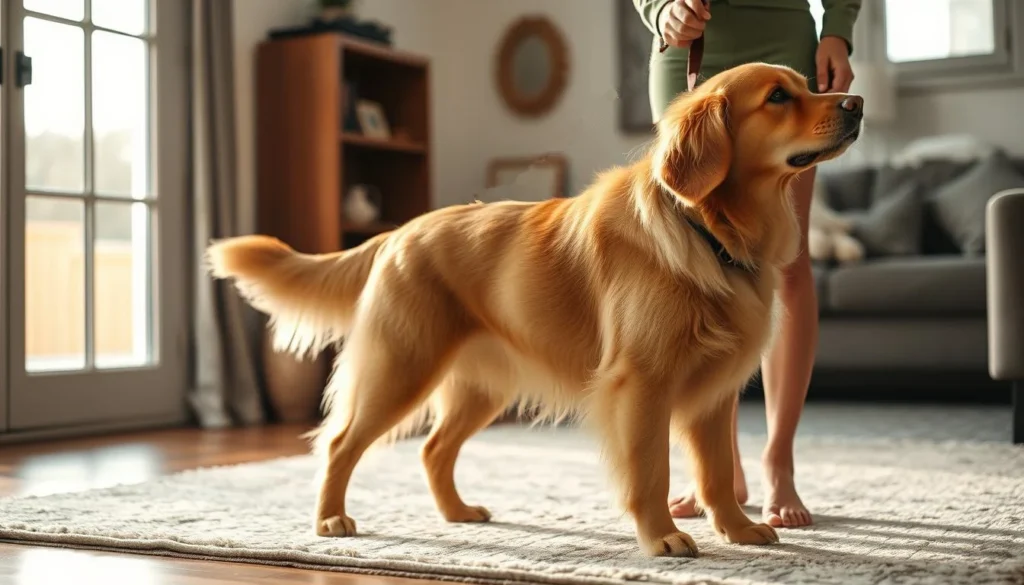
Introducing harnesses and harness fitting
I show the puppy the harness, let them sniff it, and reward calm behavior. Once the harness is on, I give soft praise and a high-value treat. If a harness pinches or rides up, I stop and adjust the fit.
Try front-clip no-pull designs briefly if raw pulling is an issue. My long-term goal in any golden retriever training program is that equipment helps, but self-control replaces it.
Loose-leash walking exercises
I keep early sessions brief and focused. Start with five-minute walks and build up as the puppy checks in more. When the pup walks beside me, I click or mark and reward.
If they rush, I stop and wait for calm attention. I use the Push Drop Stick method to raise difficulty slowly. I add small distractions, then step back if the puppy loses focus.
Safety and leash etiquette
I always maintain control on walks. Golden Retrievers have power and can bowl over small people when excited. I favor a two-meter training leash early on to allow sniffing while preventing sudden dashes.
I teach sit-and-greet before I let them meet people or other dogs. That reduces jumping and keeps meetings calm. I follow local leash laws and watch other dogs’ body language to avoid conflicts.
If I struggle, I join a leash-walking class or a local challenge. Group lessons speed progress and give real-world practice. I build recall before allowing any off-leash freedom and reward the puppy for turning back to me rather than pulling toward distractions.
When I design my golden retriever training plan, I place leash skill milestones early. These steps fit into a broader golden retriever training at home routine. Over weeks, the golden retriever training program shifts from frequent short rewards to praise and occasional treats, keeping walks pleasant for both of us.
Socialization and Handling: People, Dogs, Noises, and Places
I start socialization early with small, positive steps. This builds confidence and curiosity in puppies. My goal is to make new sights and sounds feel normal, not scary.
I use short sessions at home for different surfaces and gentle grooming. I also introduce puppies to people of all ages. These steps are key to my golden retriever training at home routine.
Early socialization tasks at home and beyond
I let puppies explore different surfaces like carpet and grass. I invite friendly neighbors and include children who move slowly. I also practice car rides to make motion feel normal.
I pair new experiences with treats and praise. This method is great for breeders, shelters, and families. It helps them make steady progress without stress.
Exposure to challenging stimuli
I introduce puppies to vacuum cleaners and traffic noise gradually. I start at low volume and let them investigate at their own pace. I teach them to say “check it out” to encourage inspection.
I also teach coping skills like “leave it” and “ignore it.” This helps them respond flexibly. Repeating these exposures during adolescence prevents lasting fear and supports long-term resilience.
Finding the right puppy class and playmates
I look for Puppy Kindergarten classes that focus on safe play and basic obedience. I choose instructors who understand breed tendencies and socialization techniques.
When picking playmates, I look for well-mannered dogs with compatible energy levels. I never force interactions. This approach helps build healthy social patterns that support a solid training guide.
Socialization is an ongoing process. I match exposures to our family activities, like boating and visiting trails. Keeping practice relevant makes training practical and lasting.
Managing Common Golden Retriever Behavior Problems
I help owners tackle common issues in golden retrievers. Clear rules, routines, and training programs solve problems quickly. I teach simple daily steps for your dog to learn what's expected.
Tackling jumping up and over-excitement
Jumping is often a sign of joy and wanting to say hello. I teach a “four paws on the floor” rule and a sit-to-greet cue. When the dog stays calm, I reward them.
When they jump, I use silence and stepping back to signal it's not okay.
Addressing mouthing and teething
Puppies use their mouths to explore. I provide safe chew toys and teach gentle play. Short time-outs stop rough play.
Following a golden retriever training puppy plan helps consistency. This speeds up learning.
Barking, separation issues, and possible aggression signs
Barking can mean boredom, excitement, or anxiety. I increase mental puzzles and walks. Then, I teach a quiet cue that rewards calm behavior.
To prevent separation stress, I start with small steps of alone time. Adding crate-based enrichment helps.
Recognizing and responding to aggression
Aggression in Goldens is rare but serious. Watch for tight lips, raised hackles, or stiff posture. I never force interactions.
If guarding or fear appears, I recommend a qualified trainer or a veterinary behaviorist. Teaching a trade or “give” with high-value treats stops resource guarding.
Practical management tips
Redirecting to good behaviors keeps progress steady. I keep rules predictable and practice short training sessions daily. Physical exercise and mental tasks reduce boredom-driven problems.
A tailored golden retriever training program with puppy steps, rewards, and clear cues offers the best results.
Advanced Activities and Enrichment for Golden Retrievers
I focus on activities that tap into a Golden’s natural instincts. This keeps both mind and body active. A balanced golden retriever training program mixes physical games with scent and problem-solving work. This prevents boredom and channels energy into rewarding tasks that build a stronger bond between me and my dog.
I start with retrieving and field sports that use the breed’s love of fetch and water. Short, structured sessions of water retrieves, bumper work, and timed fetch teach drive and control. I avoid heavy impact for young puppies and follow guidance from a trusted golden retriever training book when increasing intensity.
For mental challenge, I add scent work and nose games. Simple hide-and-seek scent trails or scent discrimination drills give a strong mental workout. These tasks fit neatly into a long-term golden retriever training plan and are easy to vary for interest.
I introduce canine sports in stages: tricks, agility, rally, and dock diving for water lovers. I enroll in local classes with positive trainers and build skills progressively. Barn hunt and scent competitions reward natural talent while improving focus. These sports help channel adolescent energy and create dependable teamwork.
Fitness and weight management matter year-round. I monitor calories during teenage growth and adjust meals after spay or neuter. Typical adult females weigh about 55–65 lbs, males 65–75 lbs. I pair aerobic work with low-impact joint-friendly exercises to protect developing bones and maintain lean muscle.
Ongoing enrichment alternates physical exercise with mental puzzles. Food-dispensing toys, hide-the-treat games, and short scent trails reduce chewing and attention-seeking. I keep grooming and mobility sessions part of the routine to support joint health and longevity.
I plan lifetime fitness routines and schedule regular vet checks to track weight and musculoskeletal health. My golden retriever training plan adapts as the dog ages, shifting intensity and focus while keeping training enjoyable and purposeful.
Conclusion
Golden Retrievers are smart, loving, and eager to please. They do best with consistent, structured training. This guide focuses on clear routines, early socialization, and plenty of activities for your dog.
Begin with basic commands like name response, sit, and recall. Add the Push Drop Stick method for more challenge. Get the right gear like a treat pouch, harness, leash, and grooming tools.
Pair home training with a good puppy class and a long-term training program. This includes activities like scent work or field sports. These help channel your dog's energy.
Be ready for fear phases and teenage testing. Stay patient, keep training sessions short and fun. Adjust your methods to fit your dog's personality.
If you see aggression or severe separation anxiety, get help from a certified trainer or vet. Use this guide as a starting point. Tailor it to your family and dog's needs.

